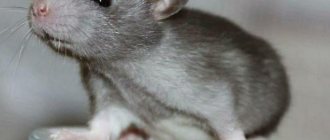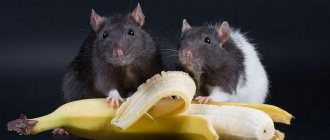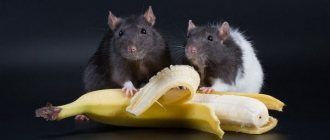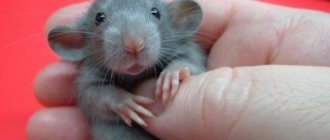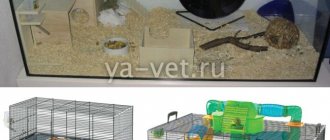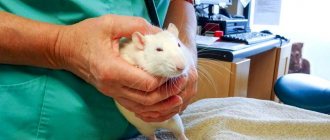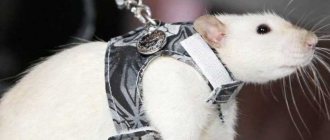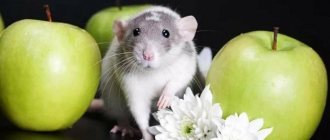- home
- Rat
- Good to know
06/21/2019 Wild rats, or pasyuks, as they are also called, can hardly be called welcome guests - these rodents pose a serious danger. They raid food products and, making their way to them, chew through everything - from wood to concrete and even metal. In addition, these animals often act as distributors of infectious infections. It is difficult to protect yourself from pasyuki, but it is possible. One of the most important stages in the fight against wild rodent pests is the detection of their homes. In summer, finding enemy nests is problematic, but in winter, rat tracks left in the snow will lead to them.
Paws of wild rats and their prints
Pasyuki are very cunning animals, so a novice tracker should be as careful as possible. Rats are capable of:
- change gait depending on various factors (snow depth, development of the territory, etc.);
- adjust the step to the maneuvers of other rodents (both smaller and larger);
- adjust the pressing force of the paws and, accordingly, the depth of the prints;
- change step distance.
Thanks to such wide capabilities of pasyuks, their tracks are very diverse, which can confuse and confuse the hunter. However, the Pasyuk's paws themselves have several characteristic features that make it possible to distinguish rat tracks from prints left by other animals.
Mouse paw prints
Mice get along well with people in the city and villages. They prefer to feed on seeds and vegetative parts of plants. Around people, they like to spoil cereals, dairy products, and stocks of meat products.
There is nowhere to see their traces in the house, unless, of course, there is a layer of dust. They can be tracked in the barn and on the street. Although the signs may vary slightly depending on the type of mouse, there are some common signs.
Features of mouse tracks depending on the type of movement
Most often, the mouse moves by jumping , so the prints look like a trapezoid, where the large hind legs protrude forward, and the small front ones are slightly behind and next to each other. At the same time, traces from the tail remain behind.
If mice move at a gallop , then the tracks are mincing, with small intervals, followed by a pair of footprints. At the same time, the tail does not leave marks; the mouse holds it suspended. In the dark, steps are more careful, the gap is greater.
Mouse tracks.
As usual the pasyuks walk
The anatomical structure of a rat's paws is such that when the animal takes a normal step, its markings are impossible not to recognize. The characteristic distinctive features of the Pasyuk's paws include the following:
- all four limbs are five-fingered;
- the fifth toe on each paw is set aside;
- on the front paws there is a kind of palm, the fingers are noticeably different from each other - four are elongated, and the fifth (large) is short, reduced, reminiscent of a stump;
- the plantar tubercles are clearly defined, distinct, and are noticeably shorter in length than rat feet;
- the length of the soles of the hind limbs is 4 cm, but only its front half is imprinted on the snow;
- The size of a Pasyuk's paw print is 2 cm2.
The structure of rat paws
The most common rat is the Pasyuk, whose tracks are very similar to all mouse-like ones. However, the paws are slightly larger.
Rat front paws
The size of the rat's footprint reaches 2*1.5 cm. The fingers are up to 10 mm long, ending in short sharp claws. If the prints are clear, the plantar tubercles will be clearly visible.
Hind legs of rats
On a large print measuring 4 cm, only the front half is visible. All 5 fingers are visible, the side ones are protruding.
On known terrain
The animal's style of movement across familiar territory is similar to ricochet - movements are fast, with frequent jumps. When entering a known territory, the pasyuk has excellent orientation; it does not need to look closely and study every centimeter of the area before taking a step.
In the developed territory, the rat does not walk, but jumps. Pushing off with her hind legs, she shifts her body weight forward and then lands on her forelimbs. When landing, the pasyuk not only groups itself, but also extends its hind legs, bringing them closer to the forelimbs. Therefore, there remains only one footprint in the snow, but from all four paws, practically pressed against each other. The distance from one such mark to another is 35 cm.
Rat anatomy: location of internal organs
Since, as we have already said, rats belong to the category of mammals, the arrangement of their organs is not much different from their relatives in biological species. In the picture below you can see all the organs in cross-section:
1 - aorta; 2 - heart; 3 - light; 4 - diaphragm; 5 - spleen; 6 - ovary; 7 - kidney; 8 - oviduct; 9 - bladder; 10 - cecum; 11 - pancreas; 12 - stomach; 13 - liver.
And here is a detailed diagram of the circulatory system of a rat:
1 - atria; 2 - ventricles; 3 - left aortic arch; 4 - innominate artery; 5 - left subclavian artery; 6 - right subclavian artery; 7 - carotid arteries; 8 - dorsal aorta; 9 - splanchnic artery; 10 - anterior mesenteric artery; 11 - renal artery; 12 - posterior mesenteric artery; 13 - genital artery; 14 - iliac artery; 15 - caudal artery; 16 - anterior vena cava; 17 - jugular veins; 18 - subclavian veins; 19 - tail vein; 20 - iliac vein; 21 - mesenteric vein; 22 - portal system of the liver; 23 - hepatic vein; 24 - posterior vena cava; 25 - pulmonary artery; 26 - pulmonary vein; 27 - azygos vein.
And we will dwell on the interesting features of their physiology.
For example, did you know that these animals have a navel, but do not have a gallbladder or tonsils? And at the beginning of the large intestine there is an appendix, which an inexperienced veterinarian can easily confuse with a benign tumor: it is so large and unusual in its structure.
Another interesting fact: these animals have poor eyesight. The rat sees space at an angle of only 16°, and it sees the world around it in gray tones. If she can still distinguish between blue and green shades, then for her the red color is darkness. Surprising, wouldn't you agree?
But poor eyesight is compensated by an excellent sense of smell and touch: mainly with their help they perceive everything around them.
Imprints on a thin layer of snow
If the ground is barely covered with snow, the rat marks will be tailless. The rodent walks calmly and slowly through shallow snow. Paw prints remain paired and clear. The pressing force of the paws is light, the depth of the prints is small, so they disappear after the first next (even light) snowfall.
When chasing prey, pasyuk leaves prints at a distance of about 70 cm from each other. During the chase, the already excellent jumping animal pushes off the ground with particular force. As for the width of the path between the paw prints, it is approximately 8 cm.
Rats' habitat is vast
Rats thrive in most environments where food and shelter are available. Norway rats can be found in homes, warehouses, office buildings, sheds, basements, sewers, landfills and other places that provide ample food. They dig holes in the ground for shelter, nesting and food storage. Burrows usually start next to buildings, fences, or other cover. Black rats do not usually dig burrows; they are found above ground level: in trees, rocks, attics, upper levels of warehouses, wall cavities and roofs.
Footprints in the snowdrifts
The Pasyuk's gait on loose, deep snow is like a two-step walk. This manner of movement is more characteristic of a weasel. The animal places its hind limb in place of its front limb, in the depression left after its step. The opposite pair of paws leaves the same markings in a checkerboard pattern.
The length of a rat's jump among the snowdrifts is 25-40 cm. The characteristic signs of the gait of a rat in deep snow include a thin strip left by the rodent's tail.
In an excessively deep layer of snow, the animal creates a whole complex of tunnels. The marks left by the rodent at the bottom of the passages have an indefinite shape and are generally uninformative.
Rats can squeeze through anywhere
A rat can squeeze through a hole the size of a quarter thanks to its collapsible skeleton. Its ribs are hinged to its spine and can fold up like an umbrella, meaning that any opening large enough for a rat's head is large enough for the rest of its body.
Photo: www, pestologyltd.co.uk
Rats can even chew their way through thick wood, metal pipes, brick walls and cement. Their front teeth are long - they grow about 12-13 cm per year - and also very sharp. To keep their teeth from becoming too long, rats must constantly chew on hard objects and sharpen the edges of their upper and lower teeth against each other, like a knife on a whetstone. The teeth will eventually grow into the brain if rats stop sharpening them.
They have incredible fertility
When it comes to reproduction, rats leave rabbits far behind. When they are not eating, they usually mate. During one six-hour receptive period, a female rat can mate up to 500 times, which helps explain how a pair of rats can eventually produce 15,000 offspring in one year and why they are the most widespread mammal in the world.
Photo: www.squeaksandnibbles.com
Rats reach reproductive age five weeks after birth, and continue to reproduce until about two years of age. Gestation usually lasts about three weeks, and litter sizes range from 6 to 20 pups. Peak reproduction occurs in spring and autumn.
The rats laugh, but we don't hear it
Rats make high-pitched chirping sounds (especially when tickled), but humans cannot hear them. Rats communicate at a very high frequency, above 50 kilohertz, so we unfortunately cannot hear their laughter without the help of a bat detection device. Rats especially love to be tickled on the back of their heads. When happy, they chatter or grind their teeth, accompanied by eye twitching. But they will stop laughing when conditions change, such as a bright light or the smell of an approaching cat. Research shows that primates such as bonobos and chimpanzees, dogs and dolphins can also laugh.
Did you know?
- All rats belong to the genus Rattus, which includes 51 species.
- Rats don't sweat. They only have sweat glands on the skin of their paws, which are not sufficient for cooling. To regulate their body temperature, they constrict or dilate the blood vessels in their hairless tails.
- The lifespan of a rat depends on whether it is a wild animal or a domestic animal. Rats kept in captivity can live up to 4 years. In the wild, they typically live 2-3 years. They are hunted by owls, hawks, snakes, dogs, cats and other predators.
- Rats have very poor eyesight. They also suffer from color blindness.
- A rat can go without water longer than a camel. Surprisingly, the kangaroo rat (genus Dipodomys) can spend its entire life in the desert without drinking water. It receives most of the moisture it needs from seeds.
- A rat's heart beats 650 times a minute!
- Cedar and pine oils are toxic to rats and should not be used as bedding.
- Rats were among the first animal astronauts. In 1961, France launched a rocket into space with a rat on board.
- Rats are clean people. Rodents, so often associated with sewers and garbage cans, are actually very clean animals. They spend several hours a day cleaning.
- The Dumbo Rat is a fancy rat with large, round ears that give it a cute teddy bear appearance, making it a very popular pet.
They are indestructible
This quality unites many movie monsters, especially serial ones: you kill them, you kill them, and by the time the next part comes out they are as good as new again.
Well, what do rats have to do with it, you ask. Common rodents. No hint of immortality. They can be anything they want, but considering them invincible is too much.
However... What is the surest way to kill a rat? I? So here it is. When rats find food they aren't sure is safe, they taste (.pdf) it first—just a little. And if they feel somehow wrong, they don’t touch this food again. They are well aware of our insidious plans and know how to destroy them.
In addition, we are increasingly faced with a completely new variety of these creatures, which scientists have already nicknamed “super mutant rats”, which are no longer affected by practically any poison.
History of origin and settlement
Paleontologists have found that the gray rat species appeared in the Pleistocene, that is, approximately 2.5 million years ago. Other rodents, including mice, already existed by that time. The next ice age that began killed many of them, but gave the gray rat the opportunity to establish itself as the most progressive species. In those distant times, these animals lived only in the territory of modern China.
From the south and east their habitat was limited by seas and oceans, from the west by insurmountable mountains, and from the north by a glacier. When it began to melt, the rats moved to new lands. Colonization proceeded unusually slowly. For more than 13 thousand years, they only reached the present-day Transbaikalia, where to this day they live well in natural conditions. Rats were encouraged to spread across the planet by people who began to actively engage in trade and navigation. About 2,000 years ago, tailed stowaways entered India on ships, from there they got to Persia, and then moved to Europe, America, Africa, and Australia. Now they are not found only in places where they have absolutely nothing to eat - in Antarctica, in the Arctic and in certain areas of the desert.
What are the differences
A mouse and a rat have similar external characteristics. The main ones are: a pointed muzzle, the absence of thick hair on the tail, and the presence of sharp incisors that continue to grow throughout the life of the rodent.
But despite belonging to the same family and the presence of a number of external similarities, there is a difference between rats and mice
Differences between a mouse and a rat
To distinguish a mouse from a rat, you can consider not only an adult animal, but also a small representative of the species. Newborn rodents also have a number of external and behavioral characteristics inherent in representatives of a separate species.
The main differences between a baby rat and a mouse are:
- The difference between a rat and a mouse is the size of the tail. In the former, its length can be up to 110 percent of the body size, while the mice have a shortened tail, the size of which is no more than 60 percent of the body length.
- Small rodents have a round and less pointed head.
- To distinguish a rat from a certain mouse, you can look at its behavior. Small rodents prefer to eat, sit or sleep, huddled in a ball, while when gathering they behave freely.
The differences between mice and rats also lie in the characteristics of their fur : in small rodents it is softer and less dense.
Video
Funny animals. Mice and rats.
The main differences between domesticated rats and mice
Decorative rodents are widely popular as pets; they are clean, unpretentious, and do not require complex care.
The differences between domesticated rats and mice are as follows::
- The chromosome set of small rodents includes twenty-two chromosomes, while their large counterparts have only twenty. This feature makes it impossible to cross representatives of different species with the aim of subsequently producing offspring.
- Domestic rodents have a large body, the length of which is more than twenty centimeters, and the weight can reach six hundred grams.
- There are also external differences: the ears of small rodents are soft, rolled into peculiar little bags, while the ears of rats are dense and pointed.
- The body of small rodents is round, while large ones are long and elongated.
The lifespan of wild mice is no more than one and a half to two years. Domesticated rats, if cared for in accordance with the rules, live longer - up to three to four years.
Differences in intelligence
The main difference between a rat and a mouse is the level of intellectual ability. Large rodents, wild and domesticated, have remarkable intelligence.
They are careful, cunning, smart . It is extremely rare that these representatives of the rodent family fall into traps, and if this happens, the unlucky individual transmits a signal to the rest of the colony, thanks to which others will avoid the dangerous place.
Unlike mice, decorative rats are easy to train, they know their nickname and respond to it, they come up with games, attracting the owner to participate. They are sociable and love to spend time with people.
These unpretentious pets can be called companions. When buying a pet, you need to take into account its age, health, and habits of the animal.
Differences in nutrition
Mice and rats are omnivores. Their diet consists of cereals and vegetables, but at the same time they will not give up meat. Wild mammals have a peculiarity - they hunt in a whole flock, choosing as prey animals that significantly exceed them in size and body weight. This behavior is not typical for mice.
During periods of hunger, animals can feed on leather, paper, soap, and other organic matter, which determines a high level of survivability. These are synanthropic mammals that prefer to settle closer to human habitation, which makes it easier for them to access food sources.
When choosing food, animals may refuse poisoned grains or seeds, which is due to the presence of a keen sense of smell.
Who is stronger
Based on the above, we can draw logical conclusions about who is stronger, a mouse or a rat: rodents with greater body mass and size exceed their smaller counterparts in strength. Separately, it is necessary to say about the intellectual level of these animals.
Due to the presence of good mental abilities and living in a large family, rats multiply quickly, increasing the size of the colony in record time.
How are the tracks different?
Traces left by rodents also have significant differences, which are as follows::
- During a jump, the distance between the tracks of small animals is thirty centimeters. The jump length of large rodents is much longer, reaching one and a half meters.
- When moving, small mammals push off with their hind legs, while leaning on their front legs. Accordingly, the footprints resemble a trapezoid. Behind the trail you can clearly see the line left by the long tail.
- The size of the rat's front paws is two by one and a half centimeters, the rear paws are four centimeters in diameter. When an animal moves quickly, prints remain, the distance between which can be up to one and a half meters. If an animal moves at a leisurely pace, a characteristic thin chain of clear tracks remains on the wet ground or snow.
It is almost impossible to confuse the tracks left by animals, since rat prints are massive in size.
Similarity in appearance
Mice and rats, despite belonging to separate species, have a number of similar characteristics.
These include:
- Lack of thick hair on the tail. The exception is the black rat; the tail of this animal is covered with thick hair.
- Round eyes black.
- Presence of sharp anterior incisors.
Similarities can also be identified according to the characteristics of behavior, nutrition, and lifestyle in general.
Rats size XXL
On average, a rat is about 40 cm long (including the tail) and weighs 450 grams. If a rat lives near a permanent food source, such as a trash can, it can grow up to 50 cm in length and weigh 0.9 kg. But this is insignificant compared to the Bosavi woolly rat, which was discovered in 2009 by a BBC expedition on the territory of an extinct volcano in Papua New Guinea. The animal was 81 cm long (including the tail) weighed more than 1.36 kg and showed no fear of people. It is believed to be one of the largest rats in the world. However, don't be afraid to meet it on the street: the rat, which scientists believe belongs to the genus Mallomys, lives only in the area of the volcano.
Photo: www.animals.fandom.com
Unfortunately, scientific research has shown that regular rats are getting larger. On the other hand, researchers believe that physiology will not allow them to turn into giant rats. They will most likely never exceed 1 kg.
